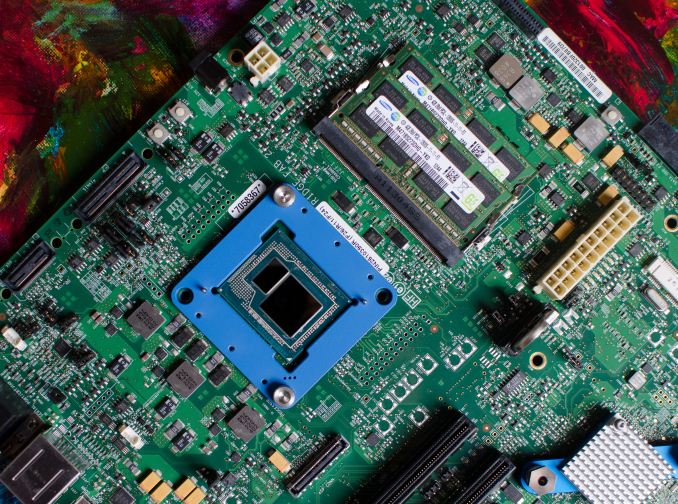Intel Iris Pro 5200 Graphics Review: Core i7-4950HQ Tested
by Anand Lal Shimpi on June 1, 2013 10:01 AM ESTFinal Words
For the past few years Intel has been threatening to make discrete GPUs obsolete with its march towards higher performing integrated GPUs. Given what we know about Iris Pro today, I'd say NVIDIA is fairly safe. The highest performing implementation of NVIDIA's GeForce GT 650M remains appreciably quicker than Iris Pro 5200 on average. Intel does catch up in some areas, but that's by no means the norm. NVIDIA's recently announced GT 750M should increase the margin a bit as well. Haswell doesn't pose any imminent threat to NVIDIA's position in traditional gaming notebooks. OpenCL performance is excellent, which is surprising given how little public attention Intel has given to the standard from a GPU perspective.
Where Iris Pro is dangerous is when you take into account form factor and power consumption. The GT 650M is a 45W TDP part, pair that with a 35 - 47W CPU and an OEM either has to accept throttling or design a cooling system that can deal with both. Iris Pro on the other hand has its TDP shared by the rest of the 47W Haswell part. From speaking with OEMs, Iris Pro seems to offer substantial power savings in light usage (read: non-gaming) scenarios. In our 15-inch MacBook Pro with Retina Display review we found that simply having the discrete GPU enabled could reduce web browsing battery life by ~25%. Presumably that delta would disappear with the use of Iris Pro instead.
Lower thermal requirements can also enabler smaller cooling solutions, leading to lighter notebooks. While Iris Pro isn't the fastest GPU on the block, it is significantly faster than any other integrated solution and does get within striking distance of the GT 650M in many cases. Combine that with the fact that you get all of this in a thermal package that a mainstream discrete GPU can't fit into and this all of the sudden becomes a more difficult decision for an OEM to make.
Without a doubt, gaming focused notebooks will have to stick with discrete GPUs - but what about notebooks like the 15-inch MacBook Pro with Retina Display? I have a dedicated PC for gaming, I use the rMBP for work and just need a GPU that's good enough to drive everything else in OS X. Intel's HD 4000 comes close, and I suspect Iris Pro will completely negate the need for a discrete GPU for non-gaming use in OS X. Iris Pro should also be competent enough to make modern gaming possible on the platform as well. Just because it's not as fast as a discrete GPU doesn't mean that it's not a very good integrated graphics solution. And all of this should come at a much lower power/thermal profile compared to the current IVB + GT 650M combination.
Intel clearly has some architectural (and perhaps driver) work to do with its Gen7 graphics. It needs more texture hardware per sub-slice to remain competitive with NVIDIA. It's also possible that greater pixel throughput would be useful as well but that's a bit more difficult to say at this point. I would also like to see an increase in bandwidth to Crystalwell. While the 50GB/s bi-directional link is clearly enough in many situations, that's not always the case.
Intel did the right thing with making Crystalwell an L4 cache. This is absolutely the right direction for mobile SoCs going forward and I expect Intel will try something similar with its low power smartphone and tablet silicon in the next 18 - 24 months. I'm pleased with the size of the cache and the fact that it caches both CPU and GPU memory. I'm also beyond impressed that Intel committed significant die area to both GPU and eDRAM in its Iris Pro enabled Haswell silicon. The solution isn't perfect, but it is completely unlike Intel to put this much effort towards improving graphics performance - and in my opinion, that's something that should be rewarded. So I'm going to do something I've never actually done before and give Intel an AnandTech Editors' Choice Award for Haswell with Iris Pro 5200 graphics.
This is exactly the type of approach to solving problems I expect from a company that owns around a dozen modern microprocessor fabs. Iris Pro is the perfect example of what Intel should be doing across all of the areas it competes in. Throw smart architecture and silicon at the problem and don't come back whining to me about die area and margins. It may not be the fastest GPU on the block, but it's definitely the right thing to do.
I'm giving Intel our lowest award under the new system because the solution needs to be better. Ideally I wouldn't want a regression from GT 650M performance, but in a pinch for a mostly work notebook I'd take lower platform power/better battery life as a trade in a heartbeat. This is absolutely a direction that I want to see Intel continue to explore with future generations too. I also feel very strongly that we should have at least one (maybe two) socketed K-series SKUs with Crystalwell on-board for desktop users. It is beyond unacceptable for Intel to not give its most performance hungry users the fastest Haswell configuration possible. Most companies tend to lose focus of their core audience as they pursue new markets and this is a clear example of Intel doing just that. Desktop users should at least have the option of buying a part with Crystalwell on-board.
So much of Intel's march towards improving graphics has been driven by Apple, I worry about what might happen to Intel's motivation should Apple no longer take such an aggressive position in the market. My hope is that Intel has finally realized the value of GPU performance and will continue to motivate itself.












177 Comments
View All Comments
Phrontis - Wednesday, June 5, 2013 - link
I can't wait for one on these on a mITX board such with 3 decent monitor outputs. Theres enough power for the sort of things I do if not for gaming.Phrontis
khanov - Friday, June 7, 2013 - link
Without a direct comparison between HD 5000/5100 and Iris Pro 5200 with Crystalwell,how can we conclude that Crystalwell has any effect in any of the game benchmarks? While it clearly is of benefit in some compute tasks, in the game benchmarks you only compare to HD 4600 with half as many EU's and to Nvidia and AMD with their different architectures.
We really need to see Iris Pro 5200 vs HD5100 to get an apples to apples comparison and be able to determine if Crystalwell is worth the extra money.
MODEL3 - Sunday, June 9, 2013 - link
Haswell ULT GT3 (Dual-Core+GT3) = 181mm2 and 40 EU Haswell GPU is 174mm^2.7mm^2 for everything else except GT3?
n13L5 - Tuesday, June 11, 2013 - link
" An Ultrabook SKU with Crystalwell would make a ton of sense, but given where Ultrabooks are headed (price-wise) I’m not sure Intel could get any takers."They sure seem to be going up in price, rather than down at the moment...
anandfan86 - Tuesday, June 18, 2013 - link
Intel has once again made their naming so confusing that even their own marketing weasels can't get it right. Notice that the Intel slide titled "4th Gen Intel Core Processors H-Processors Line" calls the graphics in the i7-4950HQ and i7-4850HQ "Intel HD Graphics 5200" instead of the correct name which is "Intel Iris Pro Graphics 5200". This slide calls the graphics in the i7-4750HQ "Intel Iris Pro Graphics 5200" which indicates that the slide was made after the creation of that name. It is little wonder that most media outlets are acting as if the biggest tech news of the month is the new pastel color scheme in iOS 7.Myoozak - Wednesday, June 26, 2013 - link
The peak theoretical GPU performance calculations shown are wrong for Intel's GFLOPS numbers. Correct numbers are half of what is shown. The reason is that Intel's execution units are made of of an integer vec4 processor and a floating-point vec4 processor. This article correctly states it has a 2xvec4 SIMD, but does not point out that half is integer and half is floating-point. For a GFLOPS computation, one should only include the floating-point operations, which means only half of that execution unit's silicon is getting used. The reported computation performance would only be correct if you had an algorithm with a perfect mix of integer & float math that could be co-issued. To compare apples to apples, you need to stick to GFLOPS numbers, and divide all the Intel numbers in the table by 2. For example, peak FP ops on the Intel HD4000 would be 8, not 16. Compared this way, Intel is not stomping all over AMD & nVidia for compute performance, but it does appear they are catching up.alexcyn - Tuesday, August 6, 2013 - link
I heard that Intel 22nm process equals TSMS 26nm, so the difference is not that much.alexcyn - Tuesday, August 6, 2013 - link
I heard that Intel 22nm process equals TSMC 26nm, so the difference is not that big.Doughboy(^_^) - Friday, August 9, 2013 - link
I think Intel could push their yield way up by offering 32MB and 64MB versions of Crystalwell for i3 and i5 processors. They could charge the same markup for the 128, but sell the 32/64 for cheaper. It would cost Intel less and probably let them take even further market share from low-end dGPUs.krr711 - Monday, February 10, 2014 - link
It is funny how a non-PC company changed the course of Intel forever for the good. I hope that Intel is wise enough to use this to spring-board the PC industry to a new, grand future. No more tick-tock nonsense arranged around sucking as many dollars out of the customer as possible, but give the world the processing power it craves and needs to solve the problems of tomorrow. Let this be your heritage and your profits will grow to unforeseen heights. Surprise us!